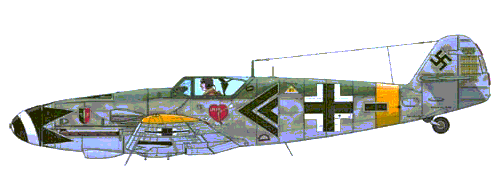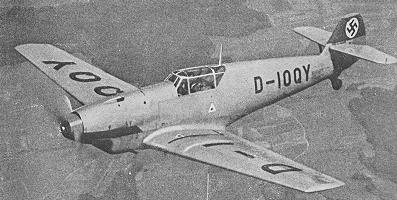
MESSERSCHMITT Bf 109G "GUSTAV"

ERICH HARTMANN'S (Bf) Me-109G WITH ITS DISTINCTIVE BLACK TULIP ON THE
NOSE
While the German Third
Reich was secretly rebuilding it's military might in the 1920's and 1930's, they designed
one of the most effective fighter planes in history. The Messerschmitt Bf 109. The Bf 109
originated in the summer of 1934, in response to an official request for a monoplane
interceptor with which to replace the Heinkel He 51 and the Arado Ar 68 biplanes.
Its designers, Willy Messerschmitt and Walter Rethel, took the excellent features of the
four-seater Bf 108 Taifun commercial aircraft as their basis and created the
smallest possible structure compatible with the most powerful engine then available. The
fighter thus took the form of a compact, all-metal, low-wing monoplane with retractable
landing gear and an enclosed cockpit. Originally it had been planned to install the new
610 hp Junkers Jumo 210A engine, but because this power plant was unavailable, the
prototype was fitted with the Rolls-Royce Kestrel V engine, generating 695 hp at takeoff
and driving a two-bladed wooden propeller.
The aircraft was completed in September 1935, and a month later it began comparative tests together with the other prototypes created in response to the same specifications. The Arado Ar 80, the Heinkel He 112, and the Focke Wulf Fw 159. The final choice left the He. 112, and the Bf. 109 in the running, and both manufacturers received an order for 10 preseries aircraft. In practice, however, the Messerschmitt project proved to be the best and in the course of its development, the aircraft was substantially modified, especially in its armament and its engine, which now became the Jumo 210A. The first aircraft of the initial production series, the Bf 109B, appeared in February 1937, and four months later they were sent to Spain.
In November 1937, a prototype fitted with an engine capable of generating 1,650 hp over short distances broke the world speed record, setting a new one of 379.07 mph (610.43 km/h). There were many variations of the Bf 109, with the B followed by the C on to the final K-14 version.
As the Bf 109 evolved , it became a deadly
weapon of the Luftwaffe. It would be used by the Condor Legion during the Spanish Civil
War to the last days of WWII against the Allied advance across Europe. Some 35,000 would
be produced. Less than a handful remain today. The Bf 109 was put up against Allied planes
that were built with technology 10 years more advanced, yet it continued to be a lethal
adversary. It's profile is timeless.
In July 1938 the firm Bayerische
Flugzeugwerke AG was redesignated Messerschmitt AG, so later Messerschmitt designs carried
the prefix "Me", instead of "Bf". After WW II began, the
Luftwaffe used the Bf 109 extensively over Europe, North Africa and the Russian Front.
When the U.S. began bombing German targets, production of Bf 109s was greatly increased in
an attempt to provide enough interceptors to blunt AAF attacks. Between 1936 and the end
of WW II, approximately 33,000 Bf 109s were built. After the war, production continued in
Czechoslovakia until 1949; and a Spanish version of the Bf 109 was produced until
1958.

Early Prototype Bf-109-V4

SPECIFICATIONS
Span: 32 ft. 6 in.
Length: 29 ft. 8 in.
Height: 8 ft. 6 in.
Weight: 6,980 lbs. loaded
Crew: One
Armament
One 30 mm Mk-108 cannon firing through propeller hub, two 20 mm MG 131
machine guns in the cowl and two 20 mm MG-151
wing mounted machine guns.
PERFORMANCE
Engine: One Daimler-Benz DB
605 of 1,475 hp.
Maximum speed: 387 mph.
Cruising speed: 325 mph.
Range: 615 miles
Service Ceiling: 38,500 ft.